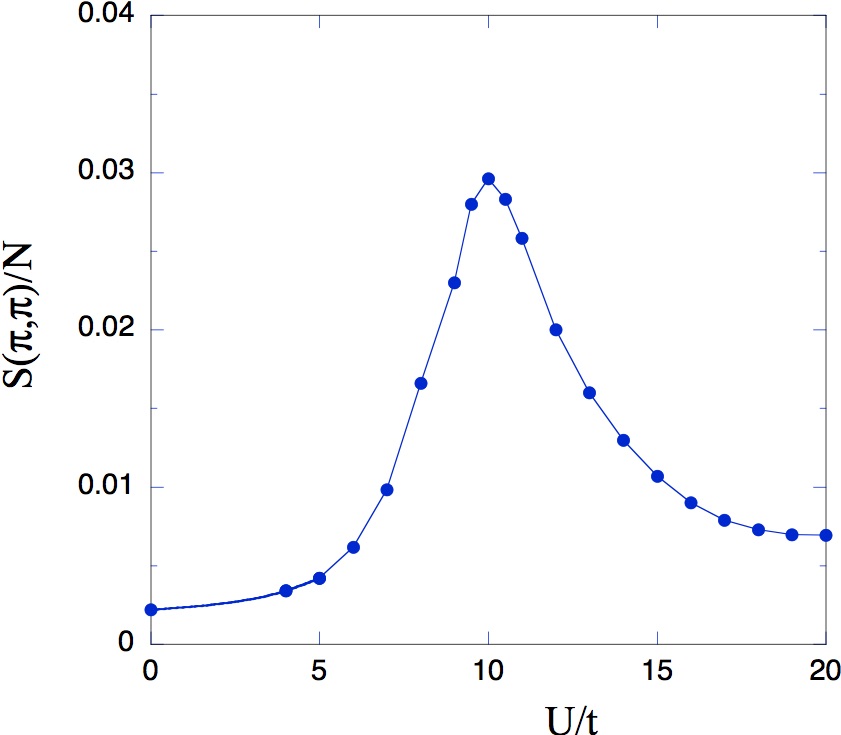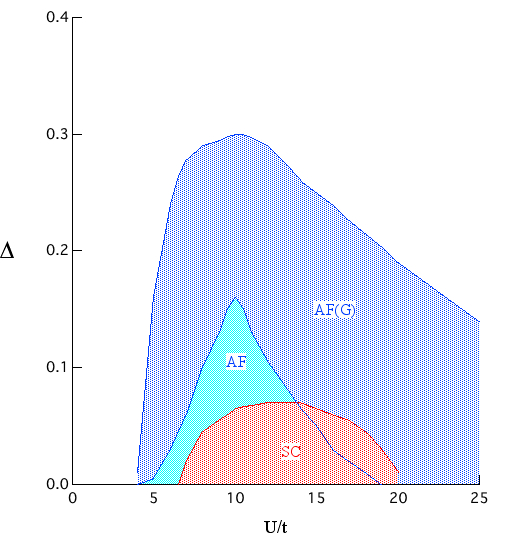In our opinion the origin of high-temperature superconductivity is spin and charge fluctuation
caused by strong electron correlation.
In order to clarify the electronic state of a system with strong electron correlation, a wave function
that correctly takes into account the electronic correlation is necessary.
In this study, we improved and optimized the many-body wave function and constructed the best wave function.
Our wave function gives the lowest energy expectation value for the ground state as compared with
wave functions proposed so far in the world.
We can calculate the expectation values correctly for the optimized wave function by using the Monte
Carlo method. We examined the electronic state of the ground state of the two-dimensional Hubbard model
and the d-p model based on the optimized wave function.
We showed that crossover from the weakly correlated region to the strongly correlated region occurs.
The antiferromagnetic correlation, when viewed as a function of the on-site Coulomb interaction U,
becomes maximum when U is approximately equal to the bandwidth, and it decreases as U becomes larger
(Fig.1).
The reason why the antiferromanetic correlation is suppressed for large U is that the energy lowering
of the ground state becomes as small as 1/U.
In order to lower the ground state energy more, the kinetic energy gain is increased by reducing the
antiferromagnetic correlation and making the holes move more easily.
When antiferromagnetic correlation is suppressed in the strongly correlated region, strong spin
fluctuation occurs. This strong spin fluctuation causes high-temperature superconductivity (Fig.2).
In fact, the superconducting correlation increases in this region.
This result shows that high-temperature superconductivity is caused by crossover from the
weaky correlated region to the strongly correlated region. The singularity caused by the crossover
is the origin of high temperature superconductivity. It is a universal phenomenon that
singularity occurs in crossover.
For example, the logarithmic singularity in the Kondo effect is caused by crossover from the
weak coupling state to strong coupling state. That is, the Kondo effect and high temperature
superconductivity belong to the same universality class.

Fig.1. Antiferromagnetic spin correlation function as a function of tbe srength of the Coulomb interaction U/t ([1]).

Fig.2. Order parameters as a function of U/t ([1]).
Antiferromagnetic (AF) and sucperconducting order parameters are shown as a function of U/t, obtained by using the
optimization Monte Carlo method. The upper curve is the AF order parameter obtained on the basis of the Gutzwiller
wave function. In the strongly correlated region where U/t is greater than the bandwidth, high-temperature
superconductivity would be possible.
文献
[1] Crossover from weakly to strongly correlated regions in the two-dimensional Hubbard model -- Off-diagonal Monte Carlo studies of Hubbard model II --
T. Yanagisawa: Journal of the Physical Society of Japan 85, 114707 (2016).
[2] Off-diagonal wave function Monte Carlo studies of Hubbard model I
T. Yanagisawa, S. Koike, K. Yamaji: Journal of the Physical Society of Japan 67, 3867 (1998).
[3] Mott transition in cuprate high-temperature superconductors
T. Yanagisawa, M. Miyazaki: Europhysics Letters 107, 27004 (2014).
[4] Incommensurate antiferromagnetism coexisting with superconductivity in two-dimensional d-p model
T. Yanagisawa, M. Miyazaki, K. Yamaji: Journal of the Physical Society of Japan 78 (2009) 013706.
[5] Gorund state of the three-band Hubbard model
T. Yanagisawa, S. Koike, K. Yamaji: Physical Review B64, 184509 (2001).
News (in Japanese)
Tsukuba Sience News
| |

